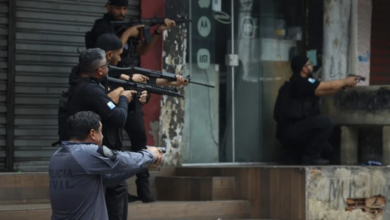Influencer’s TikTok Murder Exposes Femicide Crisis in Latin America

A chilling murder captured live on social media in Mexico has reignited urgent calls to end femicide in Latin America. New data from the United Nations Economic Commission for Latin America and the Caribbean highlights staggering realities and underscores the region’s dire need for change.
A Shocking Murder Livestreamed
The brutal killing of 23-year-old Mexican influencer Valeria Marquez stunned not just her home state of Jalisco but the entire nation. Marquez, known for her makeup and beauty tutorials, was broadcasting on TikTok from the beauty salon where she worked in Zapopan. Moments into her livestream, she expressed unease about someone who had attempted to deliver an “expensive gift” in her absence. Soon after, she uttered: “They’re coming,” just as a male voice called her name. Then, in an instant, gunshots rang out. Marquez collapsed, and the camera captured the horrifying aftermath—a hand reached to pick up her phone before the live stream abruptly ended.
Moments before her death, Ms. Marquez was sitting at a table in her beauty salon in the suburb of Zapopan, holding a stuffed animal while livestreaming. Seconds later, she was shot dead, and the footage ended only when another person picked up her phone to stop the recording. Local media reports indicate that she was killed by a man who pretended to bring her a gift. Police arrived at the scene around 6:30 PM local time (12:30 GMT) and confirmed Ms. Marquez’s death, according to the state prosecutor.
Mexican authorities have classified this murder as a femicide, recognizing it as a gender-based crime. The Jalisco state prosecutor confirmed an ongoing investigation, noting that the suspect entered the salon and shot Marquez multiple times. While no arrest has been announced, police statements emphasize a “brazen act of violence” that took place in a public setting. Marquez’s supporters, along with the larger community, have expressed indignation at the circumstances of her death.
She had nearly 200,000 followers on Instagram and TikTok. Her large social media audience made her murder a topic of national discussion. The discussion generated public anger on social media and in traditional news outlets. In her memory, people held vigils plus built memorials. These acts showed increasing worry over femicide in Mexico. The worry spreads further than her case.
Tragically, Marquez’s death reflects a pattern of violence toward women. Jalisco is ranked sixth out of Mexico’s 32 states, including Mexico City, for homicides, with 906 recorded there since the beginning of President Claudia Sheinbaum’s term in October 2024, according to data consultancy research. According to the United Nations Economic Commission for Latin America and the Caribbean (ECLAC), femicide rates stand at 1.3 deaths per 100,000 women—a figure tying Mexico with Paraguay, Uruguay, and Bolivia as the fourth-highest in the region. The reaction to this homicide has reignited demands for policy reforms, community-based prevention efforts, and systemic accountability to combat the alarming frequency of femicides nationwide.
Understanding the Alarming Femicide Data
The death of Marquez is not the only one of this kind. Data from ECLAC shows a complicated and pressing situation in Latin America and the Caribbean. With 7.2 cases for every 100,000 women, as well as the Dominican Republic, with 2.4, are at the top of this unfortunate list. Mexico has a rate of 1.3, a notably high number, as do several other nations. For every 100,000 women, Brazil, a large country in the region, has a rate of 1.4. The numbers change according to each country’s legal definitions and standards for how procedures are reported. Some nations track “feminicide,” others use “femicide,” while certain jurisdictions employ broad descriptors like “gender-related killings of women.”
According to ECLAC’s most recent updates, 11 of the 18 reporting countries in Latin America and the Caribbean revealed femicide rates above 1 case per 100,000 women in 2023. Though Mexico’s rate has decreased slightly since a previous peak in 2020, it remains unacceptably high. Meanwhile, countries like Guatemala have reduced rates from 2.3 in 2015 to 1.1 in 2020 and now just 0.5 in 2023. Yet for every small success story, other nations mark an alarming rise: Paraguay, for instance, has seen its rate climb 0.7 percentage points over the same period.
ECLAC emphasizes patterns within victim-perpetrator connections. In many nations, current or past partners did more than sixty percent of femicides. One sees Puerto Rico as different, as one hundred percent of cases that got reports fit in that group. This typical arrangement points to a frequent truth: home relationships are often deadly for women. Age also factors into the crisis: 56.4% of victims were between 30 and 59 years old, 20.3% were aged 15 to 29, and notably, 3.4% were children under 14—a harrowing reminder that girls are sometimes caught in cycles of violence.
Despite better data-collection methods in some nations, comprehensive information remains patchy. Ethnicity or migratory status are variables. Information systems in many countries do not fully capture intersecting factors. ECLAC issues a warning. Prevention efforts are less precise because of this. Legal recourse is complicated because of this. A thorough, intersectional lens is crucial, especially in a region as socially and ethnically diverse as Latin America, to safeguard girls, older women, migrants, and other groups at heightened risk.
Societal Costs and Vulnerable Groups
Each femicide leaves behind a tremendous void—both emotional and practical—for families, friends, and communities. According to ECLAC, many children lose their mothers to femicide, forcing them into precarious living conditions and state-funded care if such resources are even accessible. Countries including Argentina, Chile, Costa Rica, Cuba, the Dominican Republic, Paraguay, and Uruguay report that in 579 femicide cases, there were 488 indirect victims—mostly children suddenly deprived of parental support. This intergenerational tragedy highlights the ripple effects of gender-based violence, indicating how trauma and deprivation can perpetuate cycles of poverty, mental health struggles, and further exposure to violence.
Populations with specific characteristics are at increased risk. Women of indigenous or African heritage often experience multiple forms of discrimination as well as this makes them more susceptible to harm. Women who migrate also find themselves in unstable circumstances. Limited legal safeguards or language issues prevent help from reaching them. Women of older age sometimes do not receive attention in policy discussions – such women can experience severe neglect or abuse that is not visible. Very young girls continue to face the risk of sexual violence and violence to the body. For each demographic, femicide is merely the most brutal manifestation of a broader structure of inequality.
The underlying cultural patterns—traditionally patriarchal norms and systemic machismo—can normalize aggression against women. Socioeconomic factors, especially in contexts of poverty and urban marginalization, amplify violence. Difficult financial circumstances, inadequate school access, and few job opportunities worsen stress. Stress then results in abuse inside homes. Feeble court systems, unreliable police operations next to insufficient funds spent to stop abuse and to help victims worsen this problem. In several regions, organized criminal groups also participate. Criminal groups select women as victims. The terrible story of Valeria Marquez received less attention compared to the exciting news. This story belongs to a group of accounts. These accounts show the constant threat to women throughout Latin America.
A Call to Governments and Society
ECLAC, in its latest brief, insists that simply recording femicide cases is insufficient. The region requires forceful, intersectional public policies. These policies must address prevention, protection, and prosecution. Governments will make registry and information systems more sound. Sounder systems will contain data divided by race, ethnicity, and age next to nationality. Data of improved quality results in better understanding. This understanding involves risk factors. Improved quality data leads to more effective interventions. Timely, accurate reporting can be lifesaving, guiding law enforcement, social services, and policymakers to deploy targeted solutions.
Proposals emphasize bolstering state mechanisms—allocating sustainable budgets to agencies focusing on women’s rights, training law enforcement in gender-sensitive approaches, and embedding intersectionality in all official programs. ECLAC calls for a transformation of cultural norms that uphold violence or treat it as inevitable. Education campaigns, community outreach, and empowerment for local women’s organizations are necessary. Experts state femicide will end only when societal mindsets change along with punishing perpetrators.
ECLAC describes a caring society. It requires cohesive policies. The policies must address structural inequalities. Structural inequalities include economic marginalization, unstable labor markets, and discriminatory social practices. Handling the underlying causes is essential. For example, inflexible gender roles and insufficient work opportunities for women are underlying causes. If those get fixed, a more secure environment is achievable. Intersectional strategies will better account for factors like racism, migration status, and disability, preventing further marginalization of the most vulnerable. In short, it is an appeal for “transformative action” beyond the justice system: education, healthcare, housing, and labor must incorporate the specific needs of at-risk women.
Marquez’s murder increased public anger. Civil society groups, women’s collectives, and online communities now demand accountability. Across Mexico, vigils and social media campaigns increased. State institutions face pressure. They must expedite investigations and implement consistent protocols. The purpose is to make “Valeria’s case” not another statistic. It must not be lost in a flawed system. If any positive outcome can be drawn from this tragedy, it is the broader recognition that no nation, city, or community is exempt from femicide’s destructive force. A profound cultural shift is required to break the chain of violence. The region is at a critical point. High femicide numbers and disturbing first-person accounts show what is at stake in this struggle. Between active steps and inaction on structures is a divide.
In this divide, thousands of women face possible death. Each account increases the urgency of discussion. One is the influencer who suffered a shooting during a livestream. Another involves anonymous survivors. They seek safety in shelters. ECLAC’s data counts tragedies. It also demands immediate, coordinated changes.
Also Read: Lost Nazi Records in Argentina Spark Global Interest in Hidden Wartime Past Ties
Now, the question is whether Latin America’s governments, institutions, and citizens will heed that alarm and work collectively to end the epidemic of femicide. The high-profile nature of Marquez’s case may well provide the momentum needed to shift from shock to lasting change—an outcome essential for the region’s future and the safety of its women.





